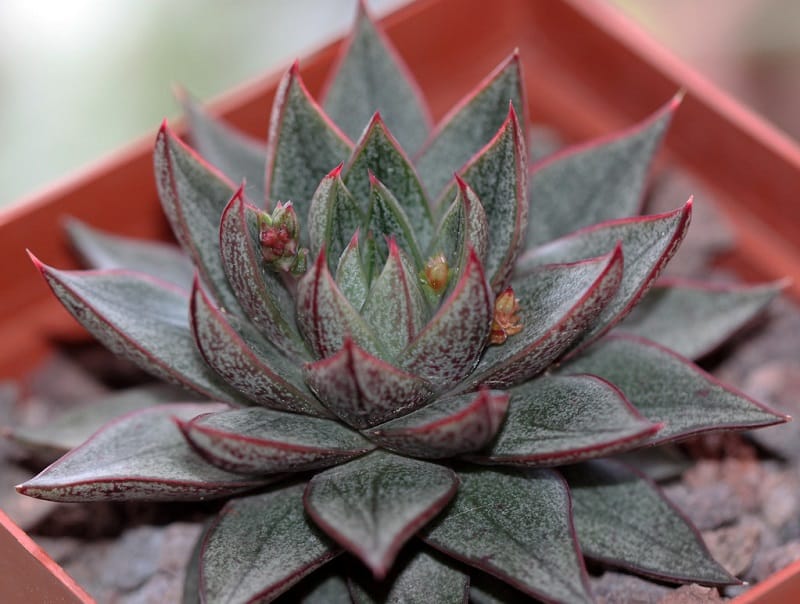Echeveria Purpusorum is one of the many echeverias originating in Mexico.
Its leaves are dark green with red spots, although the color of the leaves may change between brown, green or reddish depending on the amount of light it receives.
This succulent plant grows slowly so it does not usually bloom very often, but when it does it pulls out beautiful orange-red flowers from a long and delicate stem.
Tips to take care of the Echeveria Purpusorum
Echeverias are not complicated succulents to grow, as long as you follow some basic rules.
First, be careful not to let the water settle in the rosette between its leaves, as it can cause rot or fungal diseases that will kill the plant.
In addition, you must remove dead leaves from the bottom of the plant as it grows.
These dead leaves provide a refuge for pests and Echeveria is susceptible to mealybugs.
Plant growth
This echeveria is slow-growing that reaches a small size, up to about 15 cm in height and about 15 cm in diameter.
Its oval and plump leaves, about 4 cm long and 2.5 cm wide, are numerous and grow tight between them.
Its orange-red flowers grow on a long, thin stem of about 20 cm.
Watering
Echeveria purpusorum has the typical irrigation needs of succulents.
It is best to use the “soak and let dry” method, allowing the soil to dry completely between waterings.
As I mentioned earlier, pay attention that water is not trapped between its leaves, as this will cause the plant to rot.
Where to plant the Echeveria purpusorum
Echeveria purpusorum does not resist constant intense cold well (below -5ºC), so it is better to plant this succulent inside the house or in a container that you can take inside the house in winter.
It develops well both in full sun and in partial shade.
If the plants inside the house are sure to place it in a window or room that receives enough light.
Propagation
Echeveria purpusorum reproduces easily through its leaves, however, it takes much longer than other succulents by this method.
To reproduce this echeveria through its leaves the first thing you should do is choose a firm and healthy leaf.
Tear off the plant leaf by twisting it from the base of the stem.
Make sure that the leaf is ripped clean and that no part of the leaf is attached to the stem.
This will improve the chances of a successful spread.
Wait a few days to air dry, allowing the wound to heal, before placing it on a wet substrate with good drainage.
Water it again when the soil has dried completely.
When you see the roots appear, a small rosette has formed and the mother leaf has withered, transplant it to its final pot.
Echeveria purpusorum is perfect to include in wedding bouquets, floral wreaths or garlands. I hope you enjoy it
Conclusion
Echeverias is a large group of the family of the Crassulaceae, which are characterized by their development in attractive rosettes, of greenish-hued colors and gray, green, reddish, pink or purple tones.
The echeveria we are dealing with this post, the echeveria purpusorum, is a beautiful plant, which forms small-sized rosettes with a characteristic purple-green color.
It was described in 1930 by the German botanist Alwin Berger, who dedicated his work to the study of succulent plants.
